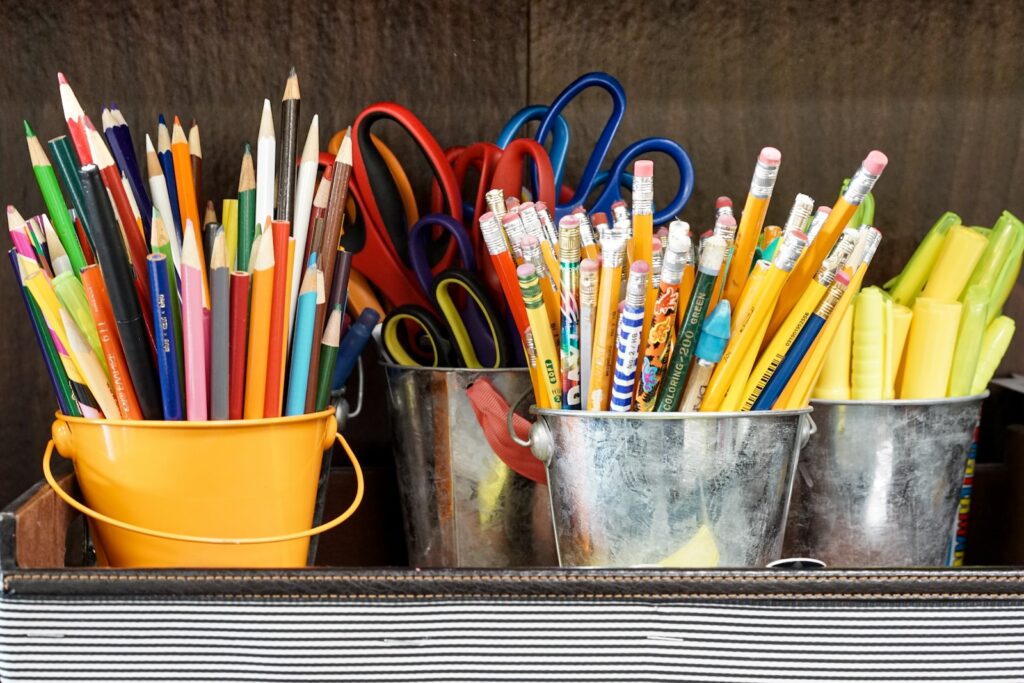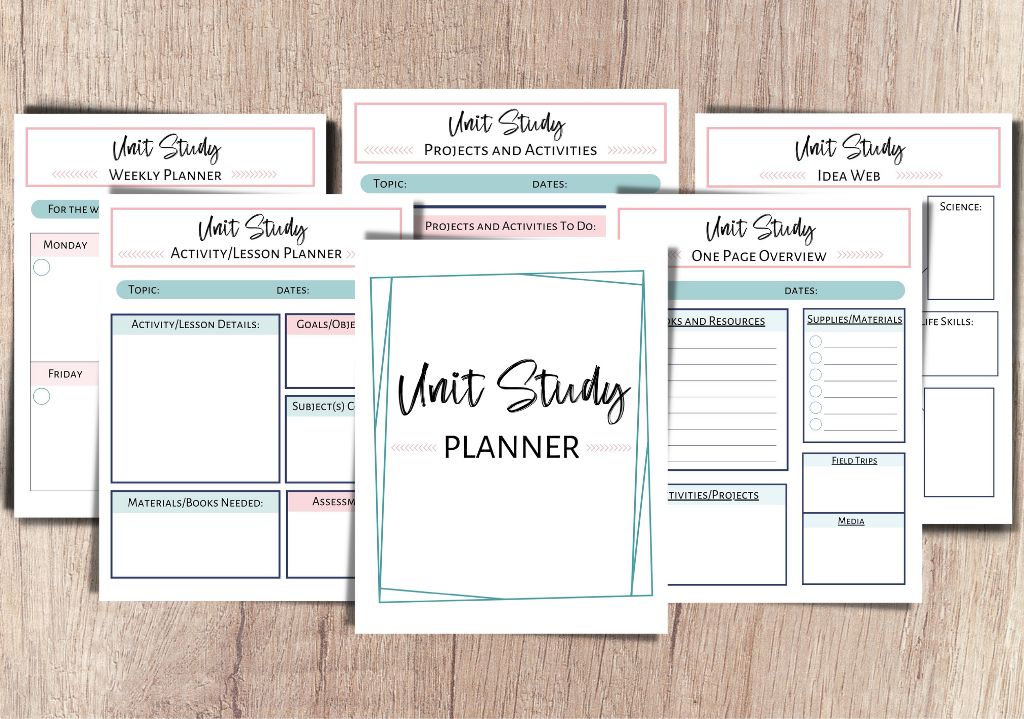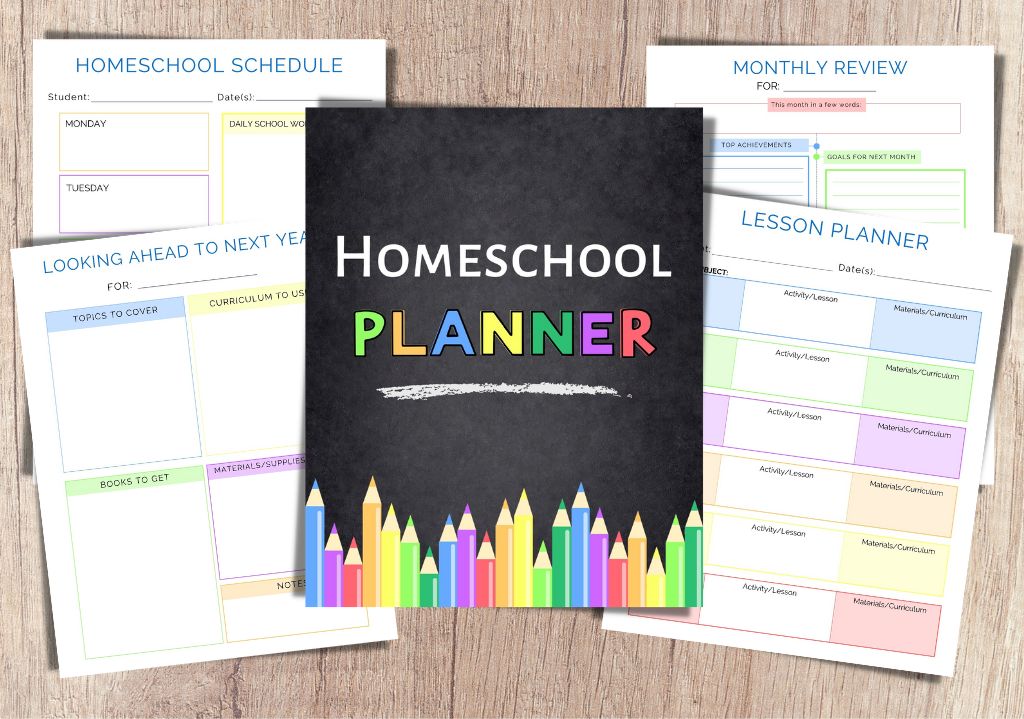39+ Helpful Homeschooling Resources – Your Ultimate Guide
Does the thought of homeschooling your children seem overwhelming at times? If so, then this ultimate guide of homeschooling resources can help!

This post contains affiliate links, meaning that I’ll earn a small commission (at no extra cost to you) if you make a purchase using these links. As an Amazon Associate I earn from qualifying purchases. See my disclosure page to learn more.
When I first decided to homeschool my two children I was overwhelmed with all of the things I had to figure out. From how to homeschool legally to what curriculum I would use, it was all so much!
Homeschooling can be a daunting task for parents and children alike, but it doesn’t have to be. With the right resources, homeschooling can provide an exciting and educational experience that both parents and students benefit from. And thankfully, there are plenty of helpful homeschooling resources available to help make the process easier.
From curriculum guides, to online classes, to books and supplies, this ultimate guide of helpful homeschooling resources will try and cover it all in order to give you the homeschooling information you need to be successful!
Homeschooling Resources For:
The Legal Side of Homeschooling
1. HSLDA
The Home School Legal Defense Association (HSLDA) is the go to place for all things involving the legal side of homeschooling in the US. Here you can find all of the requirements for your particular state so that you can begin homeschooling the correct way (legally) right from the start.
Regulations vary from state to state, so it’s really important to check what is required of you in the state you live in. And the HSLDA does a great job pointing you in the right direction. They can also give you information on homeschooling in other countries as well as if you’re a military family.
2. Time4learning
While not a legal group like the HSLDA, time4learning also has some helpful information on what each state requires in order to legally homeschool your child. They also list homeschool associations and other homeschooling resources for each state, as well as other useful information to know about when first starting your homeschool journey. This makes time4learning a good place to learn more about how to legally homeschool.
Books on Homeschooling
Of course you do not need to read every book listed here, but I’ve listed them because they all offer something that will be helpful to you as you begin (or continue along) your homeschool journey.
Some books help remind of us of the “why” of what we are doing, while others give practical advice on how to go about our homeschool days, and years. Simply look over this list of books and see which ones match where you’re at in your own homeschool journey and start there!
3. The Brave Learner by: Julie Bogart
4. Call of the Wild + Free by: Ainsley Arment
5. Teaching from Rest by: Sarah Mackenzie
6. The Unhurried Homeschooler by: Durenda Wilson
7. The Read-Aloud Family by: Sarah Mackenzie
8. Minimalist Homeschooling by: Zara Fagen
9. The Unschooling Handbook by: Mary Griffith
10. Home Grown by: Ben Hewitt
11. Homeschool Bravely by: Jamie Erikson
12. Plan Your Year by: Pam Barnhill
13. Better Together by: Pam Barnhill
Different Homeschooling Methods
When it comes to homeschooling there is no a “one-size-fits-all” way to do. There are different methods to how you homeschool as well as different learning styles for each of your children (you can read more about that further down in this post).
I have listed some of the more well known methods of homeschooling, but just know that there are other ways too. You may strictly follow one method exclusively, or maybe you’re a mix of several different styles. And what works for one family (or child) may not work for you and your family – and that’s ok! That is the beauty of homeschooling – you can pick what’s right for you and change things as needed!
Here are some common styles or methods of learning and teaching, plus helpful homeschooling resources for each one:
14. Classical
A style that teaches using three stages of learning – grammar, logic, and rhetoric. It uses a language-focused and literature-focused style of learning.
Here is a good place to go for more information on the classical method of homeschooling.
15. Traditional (aka School-at-home)
This method closely resembles a classroom in a public school, from the way the room is arranged to the materials and curriculum used.
Here is a good place to go for more information on the traditional/school-at-home method of homeschooling.
16. Montessori
Based on the teachings of Dr. Maria Montessori, this method values the development of the whole child and takes a child-centered approach to learning.
Here is a good place to go for more information on the Montessori method of homeschooling.
17. Waldorf (aka Steiner education philosophy)
This method breaks child development into three stages and places importance on educating the whole child. There is also a focus on integrating the natural world into all parts of a child’s education.
Here is a good place to go for more information on the Waldorf method of homeschooling.
18. Charlotte Mason
Some of the characteristics of this method are using living books and keeping a nature journal, as well as incorporating music, art, poetry, and literature. And it takes a more gentle, nature-based approach to learning.
Here is a good place to go for more information on the Charlotte Mason method of homeschooling.
19. Unschooling
This method promotes non-structured, child led learning over set curriculums, schedules, and textbooks. This is because unschooling’s foundation is that children are natural learners who are curious and will learn what they need naturally .
Here is a good place to go for more information on the unschooling method of homeschooling.
20. Eclectic
This method will look different for each family because it’s not based on one philosophy like other styles are. Instead, each family decides what curriculum and homeschooling resources they’ll use, picking from several different options. This method pieces together different parts of various methods to create a unique style tailored to the needs of each specific family.
Here is a good place to go for more information on the eclectic method of homeschooling.
And here are some newer terms for different homeschooling methods that you may have heard about recently:
21. Gameschooling
This newer method of learning involves using games (board games, card games, dice games, active games, online games etc.) to teach various subjects, topics, and skills. Children are learning the information while playing games, but also working towards becoming life long learners.
Here is a good place to go to for more information on the gameschooling method of homeschooling.
22. Unit studies
This can be a method of teaching all on its own, or you can incorporate it into your other teaching styles. Either way, using unit studies is a way to include all (or many) of the subjects into the learning of one topic that is studied for an extended amount of time.
Here is a good place to go for more information on the unit study method of homeschooling.
If you’re looking for an easy way to organize your next unit study, check out my printable unit study planner on Etsy!
23. Project Based Learning
This is child directed and led, and the child is the one responsible for their project and their learning. It is similar to unit studies in that multiple subjects are incorporated and being learned about as the child works through their project.
Here is a good place to go for more information on the project based learning method of homeschooling.
24. Worldschooling
This involves learning through real life experiences and exploration done outside of a typical classroom. In this method, the world around us is our classroom.
Here is a good place to go for more information on the worldschooling method of homeschooling.
25. Roadschooling
Similar to worldschooling, roadschooling is taking your child’s school on the road as you travel and typically combines real world learning and experiences with curriculum based learning.
Here is a good place to go for more information on the roadschooling method of homeschooling.
Different Learning Styles
Just as there are many different methods of teaching, there are also different ways that children learn best. Some children learn best through seeing things, while others learn by hearing them. Knowing your child’s learning style will be helpful as you move through your homeschool journey.
26. Here are the 7 different learning styles:
- Visual (spatial) learner
- Aural (auditory) learner
- Verbal (linguistic) learner
- Physical (kinesthetic) learner
- Logical (mathematical) learner
- Social (interpersonal) learner
- Solitary (intrapersonal) learner
Here is a good place to go for more information on these 7 different learning styles and how you can use this to help your child learn in the ways that are best for them.
Curriculum Choices
When it comes to deciding what curriculum you’ll use in your homeschool, the options are almost endless. It can be extremely overwhelming when you see all the choices available to you, so I have tried to break it down into different types of curriculum, as well as some examples of curriculum that is offered within each type. I hope that this information and accompanying homeschooling resources will be helpful as you try and find the curriculum that will fit your child best.
For more information about each of the following choices, you can visit that specific publishers website. Or start your research at a wonderful curriculum review site by Cathy Duffy that goes into great detail about each option.
You can also purchase her books, which will give you more information on curriculum and how to pick what works best for your child and family. It is best to purchase directly from her website, as it shows the most up-to-date, current books.
27. All-in-One Curriculum (aka Boxed Curriculum)
All of your core subjects as well as content subjects are covered in an all-in-one type curriculum. There are advantages and disadvantages to this type of “boxed curriculum,” but some families find it to be a good fit since almost everything you need is included.
Here are some of the boxed or all-in-one curriculum choices:
- Sonlight
- Master Books
- BookShark
- My Father’s World
- A Beka
- Easy Peasy All-In-One Homeschool (or High School)
- Christian Liberty Press
- Time4Learning
- Moving Beyond the Page
- Memoria Press
- Timberdoodle
28. Open-and-Go Curriculum
This kind of curriculum offers a complete teachers guide to follow that lays out all of the lessons for the year (or whatever timeframe it covers). Of course you decide how you will teach it, but all the information you need is there. You usually have to get the recommended resources on your own, such as books, supplies, and other materials, but the actual lesson plans are done for you.
Like the name implies, you just open the teacher guide and go! Ok, so it’s not quite that simple, but this type of curriculum does make it easier if you want something that covers most subjects (often times you’ll need to included math as a separate curriculum) and goes through the whole school year. If you don’t mind finding the additional resources and books on your own, and want a done for you guide book, then this type of curriculum may be for you.
Here are some examples of an open-and-go type curriculum:
- The Good and the Beautiful
- A Gentle Feast
- Heart of Dakota
- Konos
- Wayfarers
- WinterPromise
- Notgrass History
29. Pieced Together Curriculum
This isn’t actually the name for this type of curriculum, but it describes what it is pretty well! This is where you use a different curriculum or different resources for each subject. You may use publisher A for language arts, company B for math, and the curriculum from company C for science…and so on until you have what you need to cover all of the required subjects.
While this takes more time initially, since you are piecing together subjects and lessons from multiple resources, it does have some benefits. You can pick exactly what you want to cover, and at the skill levels that are best for your child. You are not tied to only one publisher and one grade level. So if your child is really strong in math, but is behind in reading you can get different levels of curriculum to meet their needs in each subject.
There are way more options for this type of curriculum than I could list here, but thankfully there is a great website that lists many of them for you. Cathy Duffy lists tons of homeschooling resources and curriculum choices for each subject and gives thorough reviews of each one, making her site invaluable when trying to pick the curriculum you’ll use.
30. Online Curriculum
The products mentioned above are all examples of curriculum with physical books, guides, and materials. They may offer other online resources as supplemental material, but the teaching is not done online.
The following sites offer classes and curriculum that is taught online. Some just cover specific subjects, while others offer a complete curriculum. Some families use only this type of curriculum in their homeschool, while others combined the use of online and physical curriculum.
Here are a few of the choices available if you want part, or all, of your child’s learning to be done online:
- Time4Learning
- Power Homeschool
- Easy Peasy All-In-One Homeschool (PreK to 8th grade)
- Easy Peasy All-In-One High School (high school level)
- ABC Mouse (for younger children ages 2-8)
- Khan Academy
- Schoolhouse Teachers
- Abeka Academy
- BJU Press
- Monarch
- IXL
- Teaching Textbooks (a full online math curriculum)
And if you chose to go the online public school or distance learning option, there’s:
Helpful Homeschooling Materials and Supplies
There’s no premade list of the things you will need when you start homeschooling. This means that you can be as minimalist or as over the top as you want! The items you include in your homeschool should be the things that fit your family’s needs, budget, and space. The materials and supplies that work for one family, may not work for another – and that’s ok! The beauty of homeschooling is that we get to decide what works best for our children and family.
Here are some materials, supplies, and homeschooling resources that you may want to include in your own homeschool. Don’t feel that you need to get everything on these lists, but rather use it as a guide to putting together the space that works for you!
31. Typical school supplies
- Pencils (any kind will work, but my favorite are the Ticonderoga brand pencils)
- Pens
- Pencil sharpener (regular or electric)
- Erasers (the rectangle kind and the pencil topper ones)
- Pencil box (or caddy, or some other type of storage for pencils, etc.)
- Paper (notebooks, loose leaf paper, computer paper, construction paper)
- Glue (the squeeze kind and glue sticks)
- Scissors
- Tape
- Stapler
- 3 ring binder
- Folders (with pockets and without pockets)
- Crayons
- Markers
- Colored pencils
- Post-It notes
- Ruler
- Clipboards
- Dry erase pockets
- Compass and protractor – or a complete geometry set (if you have older kids)
- Date stamper and ink pads (This makes putting the date on worksheets etc. so much easier!)

32. Items for Your Homeschool Space
- Globe, maps, atlases
- Magnetic whiteboard and dry erase markers
- Shelves for books, supplies, and other homeschooling resources (IKEA has some great shelving options)
- Bins or baskets to hold various items
- Table (or desk) and chairs
- Cart (for example, a three tier rolling cart or a 15 drawer organizer cart)
33. Learning Materials
- Math manipulatives
- Puzzles
- Games (board games, card games, dice games, etc.)
- Calendar
- Sensory items (Playdoh, water beads, sand, etc.)
- Building type toys
- Art materials (tempera paint, brushes, smocks, daubers, watercolors, paper, etc.)
- Learning toys
- Microscope (for younger kids and older kids)
- Magnifying glass
34. Helpful Items to Have
- Laminator and pouches (I use my laminator all the time for so many different things!)
- Printer (I have an HP printer and use the HP Instant Ink Program, so my ink is automatically sent to me each month…I love this feature! You can read more about the HP Instant Ink Program here)
- 3 hole punch
- Paper cutter
- Laptop or tablet
- Headphones
- Planner (a teacher planner as well as a student planner if they are old enough to use one)
You can check out my helpful printable homeschool planners here in my Etsy shop!
Places to Buy Homeschooling Resources
Now that you have a good idea of the things you want to have in your homeschool, you’ll need to find places to get it all from! I have included a list of online stores as well as ideas for physical places that you can go to for your homeschooling resources.
35. Physical Places/Options
- Your local department store (you can find some good deals on school supplies during the typical back to school time of the year)
- Yard sales/garage sales
- Thrift stores (I’ve found some great books at these types of shops)
- Library sales (use the Book Sale Finder website to see if any libraries near you are having sales. This can be a great time to get some good deals on books!)
- Bookstores
- Local homeschool organizations (sometimes they hold in person sales on used curriculum and other homeschooling resources)
36. Online Options
- eBay (great for finding used books)
- Amazon (they have almost everything you could need, plus the option to buy used books as well as new ones)
- Etsy (great for planners and other items)
- Thriftbooks
- Homeschool Buyers Club
- Christian Book
- PaperPie (formally called Usborne Books)
- Teachers Pay Teachers (now called TPT – great for printable resources)
- Scholastic
- Discount School Supply
- Learning Resources
- Rainbow Resource Center
- Homeschool Classifieds
- Lakeshore
- Book Outlet
Helpful Homeschooling Blogs
With so many great homeschooling resources out there it can be hard to find the ones that will be the most helpful. I have already covered resources for curriculum, materials, supplies, and the legal part of homeschooling, but what about ways to connect with, and learn from other homeschool moms (or dads)?
That’s where homeschool blogs (like this one at Simply Creative Journey!) come in! You can find real life advice, help, and great ideas from people who are going through (or have already been through) some of the same things as you are.
There are a lot of great homeschool websites and blogs, but here are some that I personally enjoy or have found to be really helpful in my own homeschool journey (in no particular order):
37. Homeschool Blogs Worth Checking Out
- Hip Homeschool Moms
- The Waldock Way
- Homeschool Super Freak
- Living Montessori Now
- Weird, Unsocialized Homeschoolers
- Raising Arrows
- The Unlikely Homeschool
- My Joy-Filled Life
- 123 Homeschool 4 Me
- Not Consumed
- Simple Homeschool
- Heart and Soul Homeschooling
- How Do I Homeschool
- Rock Your Homeschool
Learning Websites
Here are some online resources and websites that you may find useful as you go about your homeschool day and year. Some are more for you as a parent, while others provide ways for learning and having fun!
38. Websites for Learning (Free)
- Hoopla (digital platform to borrow ebooks, movies, audiobooks, magazines, and music – You will need a library card from a library that participates in this program, but thousands of libraries are partnered with Hoopla)
- Storyline Online (you can pick a book and watch it/listen to it being read)
- Prodigy (they have both an English game as well as a math game – free or paid version)
- Teach Your Monster to Read (free reading games)
- Smithsonian Institution (games, activities, videos, and virtual field trips)
- Duolingo (for language learning – free or paid version)
- Xtra Math (for math practice – free or premium/paid version)
- NASA STEM (for STEM learning for grades K to 12)
- NASA Play Space (learn more about earth and space)
- NASA Kids Club (play games and learn more about NASA)
- PBS Kids (games and videos)
- National Geographic Kids (activities, videos, games, fun facts, and more!)
- Science Bob (helpful videos and science experiments)
- Steve Spangler Science (science experiment ideas)
- Learning Games for Kids (this site offers tons of free online games for many subjects and topics)
- GoNoodle (movement activities, kids dance videos, and printables)
- Kid Power (interactive movement videos – click on the ‘for families’ link at top for more info)
- Cool Math 4 Kids (math games, lessons, and brain teasers)
- ABC Ya (online games – free and paid version available)
- Mission US (US history interactive games for middle schoolers and older)
- Starfall (math and language art games – you get a few for free, and the rest are unlocked with a paid membership)
- Fun Brain (games, videos, and books for Kindergarten to 8th grade)
- Fun Brain Jr. (games, stories, and printables for PreK and Kindergarten)
- The Old Farmer’s Almanac for Kids
- E-Learning for Kids (math and science online games)
- Crypto Club (games and puzzles using decoders and ciphers – best for older kids)
- YouTube (there are tons of great free videos covering any topic you’re learning about – but this is best when used with an adult. There is also YouTube Kids as well)
39. Websites for Learning (Paid)
- Reading Eggs or Math Seeds (you get both with a paid membership)
- ABC Mouse (full online curriculum for ages 2-8)
- Adventure Academy (games and videos for multiple subjects for ages 8-13)
- Miacademy (online homeschooling educational program for K to 8th grade)
- Night Zookeeper (reading and writing curriculum and games)
- Generation Genius (Math and science videos, lessons, activities, and kits – a bit pricey, but there is an option to try a few videos/topics out for free first)
- Splash Learn (math and ELA games for Pre K to grade 5)
- Scribd (they offer audiobooks, as well as ebooks, podcasts, magazines, sheet music and news – tons of choices for kids as well as adults )
- Leap Frog Academy (games and activities in all subjects for kids ages 3-6)
- Reading IQ (digital library full of thousands of books)
- Curious World (online games, books, and videos for children ages 2-7)
- Code Spark (coding games for kids ages 5-10)
- Kodable (another site to teach coding through games)
- Matific (math games and activities for K -6th grade)
Free Teaching Resources
Here are just a few of the places you can go to find free homeschooling resources for curriculum, lessons, activities, printables, and planning:
40. Homeschooling Resources That Are Free
- Free Homeschool Deals (printables and other homeschooling resources)
- Ology (science lessons, games, and activities from the American Museum of Natural History)
- Khan Academy (online courses)
- Easy Peasy All-in-One Homeschool (curriculum)
- Teachers Pay Teachers/TPT (set filter to ‘free’ for worksheets/printables)
- Project Gutenberg (download free books)
- Education.com (free games and printables – set filter to ‘free’)
- Ambleside (curriculum)
- The Good and the Beautiful (curriculum)
- Mensa for Kids (lesson and activity plans)
- How to Smile (lesson and activity plans)
- The Homeschool Scientist (free science lessons and printables)
- Your local library
- Virtual field trips (See a list of great places to visit virtually at We Are Teachers or The Educators Spin On It)
So there you have it! My ultimate guide to the many wonderful homeschooling resources available to you as a homeschool parent. From how to homeschool legally, to what curriculum to pick, to online resources and websites. I hope that you have found this list to be helpful as you start (or continue along) on your homeschool journey. It can be a crazy adventure, but it’s so worth it!
What are some of your favorite homeschooling resources?








